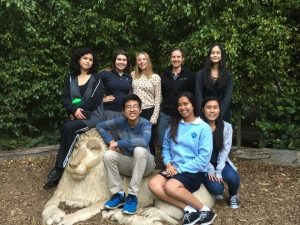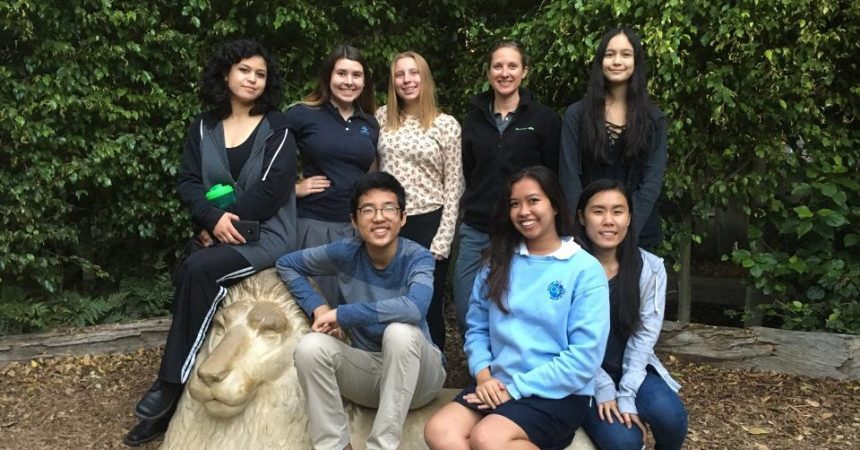Zoo InternQuest is a seven-week career exploration program for San Diego County high school juniors and seniors. Students have the unique opportunity to meet professionals working for the San Diego Zoo, Safari Park, and Institute for Conservation Research, learn about their jobs, and then blog about their experience online. Follow their adventures here on the Zoo’s website!
 Last, but definitely not least, we met Jessica Sheftel. She holds the special position of the Zoo’s Animal Welfare Specialist. With that fancy title, she helps manage how the Zoo enhances welfare for all of the animals at both the San Diego Zoo and at the San Diego Zoo Safari Park. That sounds like a monumental task, which it is, but she does not have to do it all alone. From zookeepers to nutritionists and veterinarians, Jessica Sheftel has a vast network of people to work with, all of who help provide the Zoo’s animals with the utmost quality of life.
Last, but definitely not least, we met Jessica Sheftel. She holds the special position of the Zoo’s Animal Welfare Specialist. With that fancy title, she helps manage how the Zoo enhances welfare for all of the animals at both the San Diego Zoo and at the San Diego Zoo Safari Park. That sounds like a monumental task, which it is, but she does not have to do it all alone. From zookeepers to nutritionists and veterinarians, Jessica Sheftel has a vast network of people to work with, all of who help provide the Zoo’s animals with the utmost quality of life.
As mentioned before, she focuses on improving welfare for animals. What exactly does animal welfare involve? Similar to caring for a pet dog, a Zoo animal’s welfare includes enrichment, nutrition, training, husbandry, and veterinary services. Overall, it’s the well-being of the animal. Over time, many zoos have evolved from focusing on simply displaying exotic species to placing a higher priority on saving endangered species. With an emphasis on wildlife conservation, the San Diego Zoo is immensely concerned with its animals’ welfare because to help an overall species, breeding must occur. However, animals are more likely to mate if they have high quality, fulfilling lives. This is where Ms. Sheftel comes into play. She creatively helps improve the lives of all of the animals in any way possible.
Animals have five main opportunities to thrive. The first is through well-balanced diets, which the nutritionists work hard to create and sustain. Second, the ability to self-maintain, for instance by grooming, is one that the animals can take care of by themselves. Next, optimal health is an important one, which the Zoo’s animals get from the excellent veterinary staff. The last two are expressing species-specific behaviors and getting choices and controls, which are what Ms. Sheftel focuses her time on. Those opportunities strongly focus on making the animals’ lives and behaviors comparable to the ones of their wild counterparts. By encouraging natural behaviors through things like enrichment and exhibit design, animals are more likely to have healthy offspring and help their species as a whole.
Enrichment is defined as an activity or object that benefits an animal’s overall health, both mentally and physically. More specifically, it does so in ways that encourage their natural behaviors. Therefore, the enrichment given to a panda would likely be very different from the enrichment provided to a flamingo. Plus, many of the rare animals housed at the Zoo don’t have extensive histories of adequate enrichment used at other facilities. As a result, enrichment varies greatly and that lets Ms. Sheftel be inventive and try many new things. As someone can imagine, her job has no two days alike and is a crucial part of the Zoo, which many people may not realize or think about.
Thanks to people like Ms. Sheftel, the San Diego Zoo’s and San Diego Zoo Safari Park’s animals are constantly and diversely stimulated. With numerous aspects of their lives/environments reflecting how they would live in the wild, they flourish and live their lives to the fullest. That usually involves breeding, which is great news for conservation and for anyone interested in seeing adorable babies. Next time you visit the San Diego Zoo or the San Diego Zoo Safari Park, keep an eye out for the cute little youngsters enjoying their enrichment!
Nikky, Conservation Team
Week Six, Fall Session 2017


